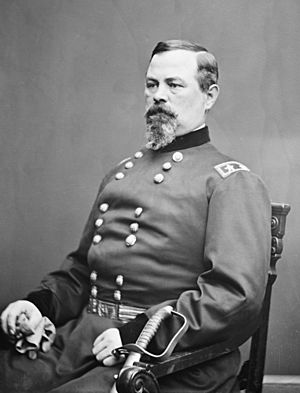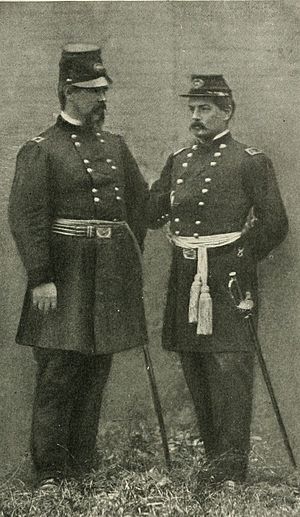Irvin McDowell facts for kids
Quick facts for kids
Irvin McDowell
|
|
|---|---|

Photo of McDowell taken during the American Civil War
|
|
| Born | October 15, 1818 Columbus, Ohio, U.S. |
| Died | May 4, 1885 (aged 66) San Francisco, California, U.S. |
| Place of burial | |
| Allegiance | United States |
| Service/ |
|
| Years of service | 1838–1882 |
| Rank | Major general |
| Commands held |
|
| Battles/wars | |
| Other work | Park Commissioner, San Francisco |
Irvin McDowell (born October 15, 1818 – died May 4, 1885) was an American army officer. He is most known for his role in the First Battle of Bull Run. This was the first big battle of the American Civil War. In 1862, he led the I Corps of the Army of the Potomac. He also fought against Thomas "Stonewall" Jackson's troops. Many blamed him for the defeat at the Second Battle of Bull Run in August 1862.
Early Life and Military Training
Irvin McDowell was born in Columbus, Ohio. His father was Abram Irvin McDowell. His mother was Eliza Seldon McDowell. He had family members who also served in the military.
McDowell first studied in France. Then, he went to the U.S. Military Academy in 1838. One of his classmates there was P. G. T. Beauregard. Beauregard would later be his opponent at the First Battle of Bull Run. After graduating, McDowell became a second lieutenant. He also taught military tactics at West Point.
During the Mexican–American War, McDowell worked for General John E. Wool. He was recognized for his bravery at the Battle of Buena Vista. After the war, he continued to work in army administration. He was promoted to major in 1856. For many years, he worked as a staff officer. This meant he helped higher-ranking generals. He learned a lot about moving and supplying armies. He became good friends with General Winfield Scott. He also worked under Joseph E. Johnston, who later became a Confederate general.
Civil War Service
McDowell was promoted to brigadier general in May 1861. He was given command of the Army of Northeastern Virginia. This promotion happened partly because of Salmon P. Chase, a government official. McDowell knew his soldiers were not ready for battle. He felt he was better at supplies than leading troops in the field.
However, leaders in Washington pushed him to attack. He launched an early offensive against Confederate forces. His plan for the First Battle of Bull Run was clever but too complicated. His inexperienced troops could not carry it out. This led to an embarrassing defeat for the Union army.
After the loss at Bull Run, George B. McClellan took command. He led the new Union Army protecting Washington. McDowell then became a division commander under McClellan. In March 1862, President Lincoln organized the army into corps. McDowell was given command of the I Corps. He was also promoted to major general.
When the army moved towards Virginia, McDowell's command stayed behind. This was because of concerns about Stonewall Jackson's actions. Later, McDowell's forces joined with other commands. They formed the Army of Virginia under General John Pope. McDowell led the III Corps in this new army.
McDowell was recognized for his actions at the Battle of Cedar Mountain. However, he was widely blamed for the later disaster at Second Battle of Bull Run. His own soldiers often disliked him. They even thought he might be secretly helping the enemy. Despite the blame, McDowell did not get new assignments for two years.
Later Career and Retirement
In July 1864, McDowell was given command of the Department of the Pacific. He later commanded other departments. These included the Department of California and the Department of the East. In November 1872, he was promoted to major general. He then commanded the Military Division of the South. From 1876, he led the Division of the Pacific. In 1882, a new law made military officers retire at age 64. McDowell retired on October 14, 1882.
In 1879, a special review board looked into the Second Battle of Bull Run. They said that much of the loss was due to McDowell. The report described him as unsure, not communicating well, and not effective. It said he failed to answer requests for information. He also did not share important details about enemy positions.
After retiring from the army, General McDowell enjoyed gardening. He became a Park Commissioner for San Francisco, California. He worked on creating a park in the Presidio. He designed roads with views of the Golden Gate. He died from a heart attack on May 4, 1885. He is buried in the San Francisco National Cemetery.
See also
 In Spanish: Irvin McDowell para niños
In Spanish: Irvin McDowell para niños
- List of American Civil War generals (Union)


